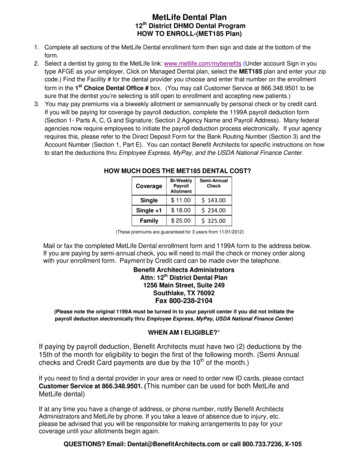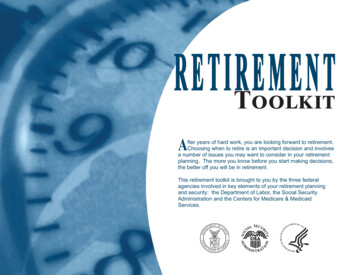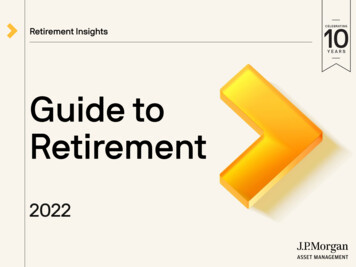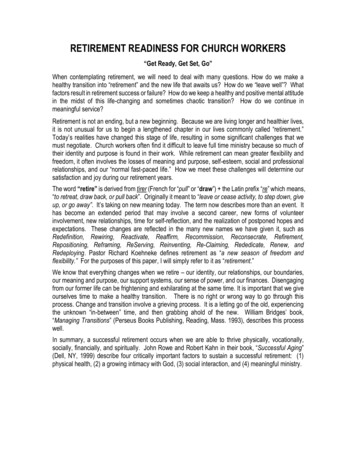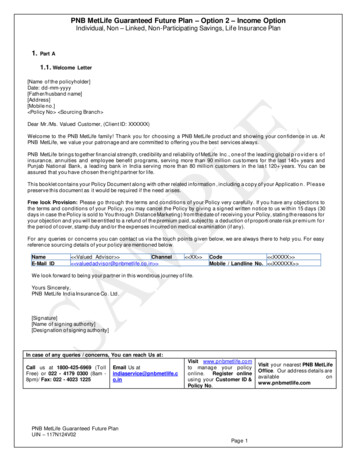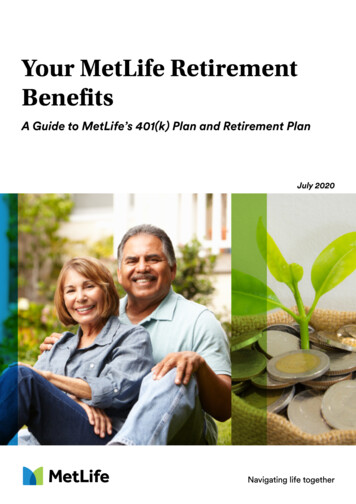
Transcription
Your MetLife RetirementBenefitsA Guide to MetLife’s 401(k) Plan and Retirement PlanJuly 2020
ContentsHow to Use This Guide. 2Realizing the Value of the Retirement Plan and 401(k) Plan. 3Your Retirement Plan. 4Your 401(k) Plan. 8Electing Your 401(k) Plan Contributions. 9Learning Investment Basics. 11Electing Your 401(k) Plan Investment Funds. 14Assessing Your Risk Tolerance and Time Horizon. 14Understanding the Market Risk-Reward Profile of the 401(k) Plan Funds. 16Putting It All Together. 17Creating Your Fund Allocations. 18Preparing for Retirement. 19Creating an Income Stream During Retirement. 20HomeNext Page
How to Use This GuideThis brochure provides a wealth of information to help you realize the value of MetLife’sretirement benefits, and learn how to use them effectively.MetLife employees are a diverse group of individuals—different ages, different financialcircumstances, different aspirations and different ways of thinking about and taking action toprepare for retirement. Yet all of us likely share the common goal of desiring a personal safety netin retirement—a secure plan for ourselves and our loved ones during our post-employment years.And each of us will likely have our own way of using this Guide to help achieve our goals.Here are a few tips to consider: Y ou may find it helpful to use this brochure now—and in the future—as a reference guide,rather than attempting to read straight through it cover to cover. R ead pages 3–6 to be sure you understand how employees earn benefits under the RetirementPlan. T hen quickly skim through the Guide to see if certain sections would be particularly useful toyou at this time. Learn about your 401(k) Plan employee contribution choices on pages 9–10. Be sure your 401(k) Plan investment fund choices match your risk tolerance and time horizon(see pages 14–18), and if you’re new to investing, review the Investment Basics topics on pages11–13. F inally, be sure to check out the section on Preparing for Retirement (pages 19–20), whichcovers:- How to Project Your Retirement Income.- How to create a post-employment income stream. F or more information, access the Your Retirement Benefits website via My HR or atwww.yourretirementbenefits.net/metlife, or call the Retirement Benefits Service Centerat 800-677-5678.Note: This brochure includes descriptions of some of the provisions of the MetLife Retirement Plan and MetLife 401(k) Plan. It is intended to be only asummary of the full terms of these plans. To the extent that the information in this brochure differs from the Plan Documents for these plans, the PlanDocuments control.Note that different provisions may apply to employees who have been rehired, employees employed by subsidiaries and affiliate companies and certainemployees whose pay exceeds limits designated by federal regulations.For additional information about the plans you should refer to the Summary Plan Descriptions and other applicable resources noted in this Guide toMetLife Retirement Benefits.Previous PageHomeNext Page2
Realizing the Value of theRetirement Plan and 401(k) PlanMETLIFE’S US employees have the opportunity to participate in two significant RetirementBenefit programs: the MetLife Retirement Plan (Retirement Plan) and the MetLife 401(k) Plan.It’sreassuring to know that as a MetLife employee you can participate in these two valuable MetLifeRetirement Benefits programs to help you achieve your retirement goals.MetLife’s funding of your Retirement Plan and 401(k) Plan benefits generally can be equal to 9% ormore of your pay each year. MetLife contributes:5%/10% After one year of service, 5% of youreligible pay* up to the Social Securitywage base ( 137,700 in 2020), and 10%of your eligible pay above the wage base,to your Personal Retirement Account(PRA); or, if you elected during “PensionChoice” in 2002 to accrue benefits underthe Traditional Formula, the Companyfunds the Retirement Plan in order toprovide your future pension benefits;plus 4% 9%or more Up to 4% of your eligible pay* to your401(k) account. For each pay period inwhich you make at least the minimum 3%employee contribution, your CompanyMatching Contribution will equal 100% ofthe first 3% you contribute, plus 50% ofthe next 2% you contribute.401(k) Plan Company MatchingContributionsYour 401(k) Plan Contributions3%4%5% or more3%3.5%4%*Eligible pay for the MetLife 401(k) Plan and the PRA generally consists of base salary, overtime, certain incentive payments includingthe Annual Variable Incentive Payment (AVIP) and most sales commissions.Important Note for former General American employees:If you participated in the GenAm pension plan on or prior to December 31, 2002 (whether you have continued to accrue pensionbenefits in the Retirement Plan under one of the “GenAm formulas” since December 31, 2002, or you have been accruing benefitsunder the Personal Retirement Account), different terms than those stated in this Guide may apply to your Retirement Plan benefits.See the Retirement Plan Summary Plan Description (SPD), or call the Retirement Benefits Service Center at 1-800-677-5678, for moreinformation.Previous PageHomeNext Page3
Your Retirement PlanMetLife’s Retirement Plan provides a solid foundation on which to help build your financial safetynet for retirement. It includes two main formulas, the Personal Retirement Account (PRA) and theTraditional Formula, which are summarized on the following pages.Here’s a quick summary of the Plan, applicable to both formulas:Eligibility/ParticipationThere is no need to enroll in the Retirement Plan—you automatically begin to earn benefits whenyou become eligible (on the first of the month after reaching one year of service, and age 21).Tax SavingsYou are not taxed on your benefit until you begin receiving payments, and at that time you maybe in a lower tax bracket than during your working years.VestingYou fully “vest”—have a right to benefits you have accrued—in your benefit after reaching threeyears of service, or when you reach age 65 with one year of service (whichever comes first).Benefit FundingMetLife pays the entire cost of this benefit; it costs you nothing.Personalized Benefit and Plan Information: Up-to-date and personalized information is availablevia the Your Retirement Benefits website and the Retirement Benefits Service Center (1-800-6775678). In addition, My HR displays personalized benefit information on the Total Compensationand Benefits Statement, detailed Plan information in the Summary Plan Descriptions andeducational material on the Retirement Plan page.Previous PageHomeNext Page4
The Personal Retirement Account(PRA)US employees hired (or rehired) in 2002 or later, or those who elected the PRA in 2002 during“Pension Choice,” earn Retirement Plan benefits under the PRA formula, which is a cash balanceplan.* The PRA is designed to provide a pension benefit that grows steadily over the course of yourcareer, regardless of your age when you join MetLife or how long you stay. It acknowledgestoday’s evolving workforce—where many people change employers several times over the courseof their career—by providing an easily calculated and portable benefit.Here’s how it works:Each month after becoming eligible, MetLife credits your PRA witha “benefit credit” equal to:- 5% of your eligible pay up to the Social Security wage base,- 10% of your eligible pay above the Social Security wage base.The wage base is a number set by the Social SecurityAdministration and indexed for inflation. For 2020 the wage base is 137,700.Beginning in each new calendar year, you accrue a benefit creditequal to 5% of your eligible pay received during each calendarmonth (effective July 1, 2018, the minimum monthly benefitcredit will be 300, even if your calculated monthly benefitcredit would have been lower than that). At the point when youreligible pay for the year exceeds the Social Security wage base,you begin to accrue a benefit credit equal to 10% of your eligiblepay received during each calendar month for the remainder of thecalendar year. In addition, the Company also credits your PRA witha monthly interest credit, based on the 30-year Treasury bond ratefor November of the prior year.The annual interest crediting rate for 2020 is 2.28%.When your benefit is paid. The PRA gives you a great deal of flexibility around receivingdistributions of your vested benefit. When you leave MetLife, you can elect to: receive your account balance as a lump-sum cash payment; or defer taxes by rolling it over into another qualified retirement plan or IRA; or defer immediate payment (and taxes) by leaving your balance in your account (up to age65, the Plan’s normal retirement age) to earn additional interest credits; or receive monthly payments by converting your lump sum into one of the plan’s annuityoptions.You may wish to consult a professional tax advisor or financial planner for advice about yourspecific circumstances. Please note IRS rules—restrictions and potential penalties can apply.Information related to plan distributions is available on the Your Retirement Benefits website.If you die before receiving your benefits. Your beneficiary can receive your vested lump-sumbalance immediately as either a single payment or annuity. See the Summary Plan Description formore detailed information on the Pre-Retirement Death Benefit under the PRA.*Employees who elected the PRA during “Pension Choice,” or who were rehired in 2002 or later may have a Retirement Plan benefit that consists of two parts: a“preserved” (frozen) Traditional Formula benefit, and a PRA lump-sum benefit.Previous PageHomeNext Page5
The Traditional FormulaUS employees who were hired prior to 2002, and did not elect in 2002 to accrue benefits underthe PRA formula during “Pension Choice,” accrue benefits under the Traditional Formula of theRetirement Plan*. The Traditional Formula provides a benefit that is based on Final Average Pay(FAP, see below), years of service, Covered Compensation (CC, see below) and age when youleave the Company, as defined by a formula provided in the Plan Document and summarizedbelow. Benefits can only be paid in the form of an annuity, and generally become payable onlywhen you become eligible for early distribution of your benefit (e.g., you terminate employmentand are at least age 55 with 15 years of service).Here’s how it works:The Traditional Formula benefit is calculated as follows:1.1% of FAP upto CC timesyears of creditedservice (up to35) 1.7% of FAPabove CCtimes years ofcredited service(up to 35) 0.5% of FAPtimes years ofcredited serviceabove 35 Your annualannuity paymentat age 65 (normalretirement age)Your Final Average Pay (FAP) depends on whether you are salaried or commissioned: I f you are salaried, FAP is the average of your annual eligible pay for the highest 60consecutive months during your last 120 months of service. I f you are commissioned, FAP generally is the average of your eligible pay during the highestfive calendar years (not necessarily consecutive) during your last 15 completed calendar yearsof service.When your benefit is paid. Your benefits can only be paid to you after you terminate employmentwith MetLife. You will receive 100% of your benefit if you wait until age 65 before starting yourannuity payments (or until age 62 if you have 20 or more years of service)—otherwise, your benefitwill be reduced.Social Security wage base. You and MetLifeCovered Compensation, which isboth contribute a percentage of your paydetermined and published by the Internalto Social Security—up to a specified payRevenue Service (irs.gov), generally is thelevel called the Social Security wage baseaverage of the Social Security wage bases(which generally increases each year, andfor the 35 calendar years ending with theequals 137,700 for 2020). You do not makeyear in which you begin receivingcontributions to, or receive a benefit from,benefit payments under the plan. If youSocial Security on pay you earn above theleave MetLife before reaching the age andwage base (although Medicare contributionsservice requirements for payments toare still necessary). By taking coveredbegin, a higher covered compensationcompensation into account in the Traditionalrate is used based on the year of your birth.Formula (shown above), MetLife coordinatesyour Retirement Plan benefit with SocialSecurity.For information about reduced benefits based on early distribution of your benefit, see theSummary Plan Description and My HR’s Retirement Plan page.*Traditional Formula accruals under the MetLife Retirement Plan will end effective December 31, 2022. Accruals beyond that date will be under thePersonal Retirement Account formula for all eligible employees. Visit My HR Benefits for details.Previous PageHomeNext Page6
How Much Retirement IncomeDo You Need?Now that you’ve reviewed your Retirement Plan, and before we turn to the 401(k) Plan, let’sconsider the general issue of saving for retirement. You’ve been hearing a lot about the erosionof traditional government and corporate safety nets, as well as the significant and rising cost ofhealth care and long-term care. So how much savings will you need and where will it come from?Retirement incomes in the US historically have come from three major sources—Social Security,corporate pension plans and personal savings. While MetLife continues to provide a strong foundation to employees by maintaining a defined benefit pension plan, we must also consider thatSocial Security benefits may be reduced or taxed more heavily in the future due in part to the largenumbers of “baby boomers” entering retirement.The bottom line—experts say that the majority of employees in the US will need to saveregularly throughout their working career in a savings plan like the 401(k) Plan in order tocreate the income they’ll need during retirement.Are you on target today?That’s not an easy question to answer. Some experts suggest that during your retirement years,you’ll need approximately 70–80% of the income you earn during your working years. Others say90–100% or more. In fact, each of us is in a unique position, with factors like our intended lifestyle,our health condition, outstanding debt, etc.—so there’s no easy formula that works for everyone.One simplified study is shown in the bar chart below. For example, a 65-year-old who earns 100,000 and needs 80% of that income level during retirement, may need 1.5 million accumulated in savings and retirement plans. And a 45-year-old who earns 50,000 today may need 205,000 accumulated so far (4.1 x 50,000).Multiply today’s income by:How Much to Have Saved15.011.415. 08.56.14.145Assumptions:80% income replacement ratio.- Includes full Social Security benefit, but no otherretirement benefits.- 4% annual real rate of return.- 4% inflation-adjusted distribution rate.- 30-year life expectancy in retirement.Source: Charles Farrell, Dorman Farrell LLC (taken from Money magazine).505560YOUR AGE TODAY65Did You Know?The average 401(k) Plan account balance for MetLife employees aged 55 or more,who have five or more years of service, is approximately 250,000. (Of course,401(k) Plan participants may also have accrued Retirement Plan benefits andoutside savings, including those of their spouse/partner.)Where do you stand today? Are you on target at this point?Previous PageHomeNext Page7
Your 401(k) PlanMetLife’s 401(k) Plan offers you one of the best ways to help you reach your financial goals inretirement. If you’re not contributing to the 401(k) Plan, you are missing out on a great opportunityto save on your own for retirement, and you are not taking advantage of the Company MatchingContribution.Why participate in the 401(k) Plan if the company gives me the retirement plan?Studies show that today, many Americans aren’t saving enough for their retirement. With the erosion of government benefits and continued rise in health care and assisted living costs, it’s important that you save for retirement consistently and early—“early” because of the effect of potentialcompound investment returns, and “consistently” because that’s critical for accumulating assetsover the long term. One of the best reasons for participating in the 401(k) Plan is the fact thatMetLife matches your contributions, giving you additional money to save and invest.The MetLife 401(k) Plan offers many advantages:Company Match. Your 401(k) account will receive Company Matching Contributions equal to100% of the first 3% of your eligible pay you contribute, plus 50% of the next 2% you contribute, foreach pay period in which you make at least the minimum 3% employee contribution. That meansyou have the opportunity to receive a 4% Company Matching Contribution on each paycheckfor which you contribute at least 5% of your eligible pay! Participants are immediately eligible forCompany Matching Contributions and are immediately vested in those Contributions, regardlessof their length of service.Payroll Deduction. It’s so easy and convenient to contribute to the 401(k) Plan through automaticpayroll deduction.Flexibility. You have at least three ways to contribute to the 401(k) Plan (see page 10) and anumber of ways to invest, depending on your time horizon and risk tolerance (see pages 14–17).Tax Advantages. You are not taxed on the amount of your employee before-tax 401(k)contributions or on the Company Matching Contributions in the year that they are deposited inyour account. In addition, investment earnings on all plan contributions grow tax-deferred or taxfree until you ultimately take a distribution from the Plan.Roth 401(k). MetLife was one of the first employers to offer the Roth 401(k) when it becameavailable in 2006; it provides for tax-free investment earnings in certain circumstances (see page10 for additional information).Compound Investment Returns. Over time, the more investment earnings you leave in youraccount, the more money you have working for you, and the more you may ultimately accumulate,especially if you start contributing early in your career.Low Costs. The Company pays the majority of administrative costs to operate the Plan, there aregenerally no transaction fees, and the investment expenses on the 401(k) funds are low relative tocomparable funds outside the Plan. For more information see the Summary Plan Description andthe MetLife 401(k) Plan Annual Fee Disclosure Statement available from Plan Resources on theYour Retirement Benefits website Home Page.Previous PageHomeNext Page8
Electing Your 401(k) PlanContributionsAuto Enrollment & Contribution Rate EscalationEligible employees hired or rehired on or after January 1, 2019 are automatically enrolled in theMetLife 401(k) Plan to contribute 5% of pay on a before-tax basis. This contribution rate will automatically increase by 1% each April up to a maximum of 10% after five years. Contributions will beinvested in the Balanced Index Fund, the Plan’s Qualified Default Investment Alternative, unless theparticipant makes a different election. Participants can change their contribution rate, automaticescalation elections, and investment options at any time.Contribution limitsInternal Revenue Service (IRS) rules impact the maximums you can contribute to the 401(k) Plan.These limits generally change from year to year—see “What’s New” available from Plan Resourceson the Your Retirement Benefits website Home Page.Catch-up ContributionsIf you reach age 50 or older at any time during the year and you maximize your 401(k) contributionsallowed for the year, you may contribute up to an additional 6,500 (for 2020) in 401(k) savings toyour 401(k) account in the form of “catch-up contributions.” This step could be important if yoursavings are not on track to create a secure retirement (see page 7).Can’t Afford to Invest in the 401(k) Plan? You Can’t Afford Not ToA common objection for not participating in the 401(k) Plan is that employees cannot afford anymore payroll deductions. While each employee has his or her own personal circumstances, animportant principle among smart savers is to “pay yourself first.” No matter what percent of yourpay you decide to contribute to the 401(k) Plan, with even the minimum 3% employee contribution,you’ve taken an important step to help build your personal financial safety net for retirement.And in order for your 401(k) account to receive a Company Matching Contribution and potentialinvestment returns, you have to make your own employee contributions.Enrolling in the 401(k) Plan on Your Retirement Benefits:You can access the website using single sign-on through My HR. Follow the prompts to get tothe Start Saving link. Then elect your employee contribution rate(s) and investment fund(s). Thefollowing pages provide education to help you with these choices.Previous PageHomeNext Page9
Three Types of EmployeeContributionsThe MetLife 401(k) Plan offers you three different types of employee contributions, giving you agreat deal of choice and flexibility to manage both your account and the income tax consequencesof contributing to your 401(k). Any combination of the following three contribution types countstoward the minimum 3% employee contribution needed to participate in the Plan and qualify toreceive a Company Matching Contribution in your 401(k) account. Pre-tax 401(k) contributions provide you with a tax benefit now - by reducing yourtaxable gross income in the year contributions are made. However, when you retire, both yourcontributions and any investment earnings will be taxed based on your tax bracket at retirement.This approach could be to your advantage if you want tax savings now and don’t mind having topay taxes during retirement when you may be in a lower tax bracket than you are in today. Roth 401(k) contributions are taxed now - so you don’t reduce your taxable gross incomeduring the year in which your contributions are made. However, when you retire you canwithdraw your Roth 401(k) contributions and investment earnings tax free (provided that you areat least age 59 and half, and the Roth account is at least five years old). This approach could beadvantageous if you don’t mind paying taxes now, and prefer to have tax-free income atretirement, or if you anticipate being in a higher tax bracket during retirement than you arein today. After-tax contributions are taxed now - so you don’t reduce taxable gross income during theyear in which your contributions are made. When you retire, you can withdraw your After-taxcontributions tax free; however, investment earnings will be taxable to you based on your taxbracket at retirement. This approach could be to your advantage in further diversifying yourtaxable and non-taxable retirement savings, and allows you to save additional amounts over theannual limit on 401(k) contributions. See the Summary Plan Description for rules and potential taxpenalties related to withdrawals made prior to reaching age 591/2.MetLife 401(k) Plan Employee Contribution Types:Pre-Tax 401(k)Roth 401(k)After-TaxTaxability of ContributionsNot taxed in year contributed,taxed in year withdrawnTaxed in year contributed, nottaxed in year withdrawnTaxed in year contributed,not taxed in year withdrawnTaxability of EarningsTaxed in year withdrawnNot taxed*Taxed in year withdrawn2020 Annual 401(k)Employee ContributionLimit 19,500, in combinationwith Roth 401(k)** 19,500, in combinationwith Pre-tax 401(k)**N.A.2020 Additional Catch-upContribution Limit 6,500, in combinationwith Roth 401(k)*** 6,500, in combinationwith Pre-tax 401(k)***N.A.Eligibility forCompany Match****EligibleEligibleEligible* The distribution generally must occur after the participant reaches age 591 2, death or disability, and the first Roth contribution must be at least five years old to avoidtaxability on the earnings.** Pre-tax 401(k) and Roth 401(k) contributions are added together to calculate your 401(k) maximum contribution (19,500 for 2020), as well as the 16% per-paycheck401(k) contribution maximum for “highly compensated employees” (i.e., you earned more than 125,000 in 2019 from MetLife or an affiliated company). Non-highlycompensated employees are limited to a maximum employee contribution of 45% per paycheck in combined Pre-tax 401(k), Roth 401(k) and/or After-tax contributions.*** Pre-tax 401(k) and Roth 401(k) employee contributions are added together to calculate your catch-up contribution limit ( 6,500 in 2020). Catch-up contributions areavailable for employees who will reach age 50 or older in 2020.**** Company Matching Contributions and their investment earnings are not taxed until distributed from the Plan.Previous PageHomeNext Page10
Learning Investment BasicsIf you are new to investing, the following Investment Basics topics may provide a helpfulfoundation for electing your 401(k) investment funds (see pages 14–18).Compound Investment ReturnsInvestment returns are the gain or loss in the value of an investment or fund, oftenexpressed as an annual percentage, or “rate of return.” Compound investment returnsoccur when your investment returns are not withdrawn from your account, but ratherremain in your account to be invested. When returns are positive you can earn “returnson your returns,” which can increase your account value like a snowball effect.The sooner you begin to invest, the more years you have to take advantage of compoundinvestment returns. The graph below shows the effect of compounding over time.Market Risk and ReturnMarket risk is the possibility that the value of your investment will decline over time due to a varietyof factors that impact the stock and bond markets, which are difficult to control or predict. However, market risk and the potential for investment returns generally go hand in hand. If you wantlow risk, you may have to settle for lower returns that may be lost after factoring in the impact oftaxes and inflation (see page 13). If you want to aim for higher returns, you may have to be willing totolerate more market risk.Growth of a Single 10,000 Investment Over 20 Years* 50,000 46,610AnnualReturn: 40,000 32,0718% 30,000 21,9116% 20,0004% 10,000 005101520YEARS* The above graph is for illustrative purposes only. It does not represent the actual return on any investment or MetLife 401(k) Fund, and assumes noloans or withdrawals were taken.Previous PageHomeNext Page11
Learning Investment BasicsDiversifying to Manage RiskDiversification means spreading your savings among several types of investments—not puttingall of your eggs in one basket—so that if some of your investments decrease in value, others mayincrease. Diversification is a way of managing risk, especially if you’re investing in funds that havehigher market risk.You can diversify across asset classes by investing some of your account in lower risk investmentslike the Fixed Income Fund, some in low to moderate risk investments like the Bond Index Fundand the rest of your account in the moderate- to high-risk stock funds; or diversify within anasset class by investing in several stock funds that have different investment objectives and levelsof risk—for example, US large, mid-cap and small company stock funds and international stockfunds. The core investment funds in the MetLife 401(k) Plan provide an array of asset classes fromwhich to choose to help build a diversified investment portfolio (see page 16).Using Time to Manage RiskYou can adjust your fund allocation to match the amount of time you have until you’ll need yoursavings. If you plan to use your savings in the short term, say within three to five years or less, itwould be risky to have a large percentage of your savings in the more volatile investment fundsbecause there is less time to make up for periods of declining markets. But if you’re investing forthe long term, say 10 or more years, inflation risk (see page 13) may be a bigger concern. Theshort-term volatility of stock funds may be balanced out by the potential for larger long-term gains.In general, stock funds have outperformed more conservative stable value funds (like the FixedIncome Fund) over long periods of time. Of course, past performance is not a guarantee of futurereturns, but you may want to consider overall market trends for guidance.Caution on Market TimingNo one really knows when the market is going to go up or down. And one mistake investorssometimes make is trying to react to short-term changes in the market. A more effective strategymay be to determine a fund allocation that fits your time horizon and risk tolerance. Then, transfer your money gradually over time as your goals or time horizon change—rather than makingshort-term reactions to small changes in fund values. Although tempting, “chasing the market” canreduce your overall investment perf
The Personal Retirement Account (PRA) US employees hired (or rehired) in 2002 or later, or those who elected the PRA in 2002 during “Pension Choice,” earn Retirement Plan benefits under the PRA formula, which is a cash balance plan.* The PRA is designed to provide a pe
